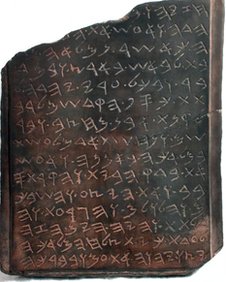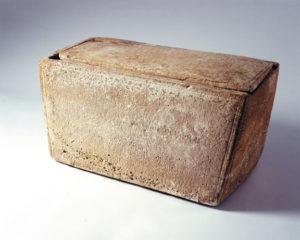Archaeological Demonization

In Israel, the situation is a bit different but it parallels the phenomenon overseas. Here, the archaeological establishment is driven by concerns other than Christian theology, but the net effect is the same – marginalize and demonize. The fact is that Israeli archaeologists are happy to find nothing related to Jesus. After all, they are by and large Jewish and they regard Jesus as the founder of Christianity. So whatever early Christian artifact they find, they either date late or they say it’s not Christian. This fits well with the Christian agenda because the theologians don’t want the Jewishness of the early Jesus movement to contradict the Christ of their theology. In other words, Christian theologians and Israeli archaeologists are happy to keep the 1st century empty of anything related to the birth of Christianity. The Christians don’t want Jesus to be too Jewish, and the Jews don’t want 1st century Israel to be too Christian. A marriage made in heaven.
In addition, in Israel, it’s very important who finds an artifact. Recently, the bone box or ossuary of “Miriam, daughter of Jesus, son of Caiaphas” made headlines. Caiaphas is the High Priest who, according to the gospels, sent Jesus to the Romans who sent him to the cross. It turns out Caiaphas had a son named Jesus…interesting. Anyway, the ossuary emerged out of the antiquities market. Because the first people to get their hands on it were Professor Yuval Goren and Professor Boaz Zissu of Tel Aviv and Bar Ilan Universities, the unprovenanced item was deemed to be authentic. Had the same artifact been brought to light by Antiquities dealer/scholar Robert Deutsch or Hershel Shanks, the editor of Biblical Archaeology Review (BAR), the very same Goren would have surely declared it a fake. Basically, the rule in Israel is; “if I don’t find it, it’s a forgery”.
Which brings me to the latest bizarre turn in the strange case of Oded Golan, the antiquities collector who was accused of forging the now infamous inscription on a 1st century bone box or ossuary which reads; “James, son of Joseph, brother of Jesus”. In 2003, my first film on Jesus related archaeology was on this artifact (James, Brother of Jesus).

Golan has been tortured for 9 years with house arrest, incarceration, public humiliation and prosecution. For 9 years he was dragged through the Israeli court system. The prosecution accused him of forging the words “brother of Jesus”, and of further forging, among other artifacts, the so called “Jehoash Tablet”. The tablet seems to be the first ever Biblical artifact connected to the Temple of Solomon, which stood on Mount Zion for nearly 500 years. It is a perfect fit with statements in the Bible (2 Kings 12) describing Judean King Jehoash’s renovation of the Temple.
Until now, the prosecution had said that Golan was a forger and that various items in his collection were the result of his nefarious art. But the prosecution’s case fell apart in court. It couldn’t prove anything. Its witnesses fell apart on the stand. For example, Joe Zias, a former curator at the Israel Antiquities Authority, had said that he had seen the original inscription without the words “brother of Jesus” at the end of the inscription. The prosecution hailed him as a great expert with an incredible memory. In court, Zias could not testify in Hebrew. It turns out that he is not an expert on Hebrew and Aramaic inscriptions. He’s not even an expert in modern Hebrew. Humiliatingly, he could not even read his own name “Joseph” on the ossuary! Furthermore, under cross examination, he admitted that he never actually saw the inscription. His accusations were based on what an Arab antiquities dealer told him decades ago, as they were having coffee together in Jerusalem’s old city.
Professor Goren didn’t do much better. At first he had said that his “isotope” reading of the patina, or encrustation, inside the inscription proved that Golan was a forger. I won’t bore you with the technicalities of the isotope test. Suffice it to say that, under oath, Goren admitted that the isotope reading was consistent with the inscription being authentic. He also admitted that one of the key letters in the word “Jesus” passed all isotope tests with flying colours. The court ruled in favour of Golan. But here’s the twist – as reported by Matthew Kalman, the prosecution now seems to be claiming that the items are authentic and that the State should get to keep them. No, you didn’t misread. For 9 years, they kept Golan’s artifacts because they said they were forgeries, but now that the court has ruled in favour of Golan, the prosecution claims that these are national treasures that have to be kept by the State of Israel. One of the Supreme Court judges, with trembling hands, caressed the Jehoash inscription and ruled in favour of the prosecution (see: http://jamestabor.com/2013/08/01/strange-twist-in-the-oded-golan-case-is-the-jehoash-tablet-genuine/).
Golan is understandably upset. They raided his house, they took his artifacts and they called him a forger. Then, when he won his case, instead of returning his property back to him, they declared his artifacts a national treasure. At one point, in the proceedings, when the illogic of the prosecution’s position was pointed out, the prosecution did a verbal somersault; we still maintain, they said, that the inscription is fake. It’s the stone that’s real…and really ancient. At this point, someone in the courtroom pointed out that all stones are ancient. This would all be funny if it wasn’t tragic.
The intellectual inquisition must stop. The persecution of academics like Reza Aslan and collectors like Oded Golan has to stop. Let the historical chips fall where they may, let the theologians go back to theology and the archaeologists go back to their digs, and let freedom reign when it comes to the debate about history.

